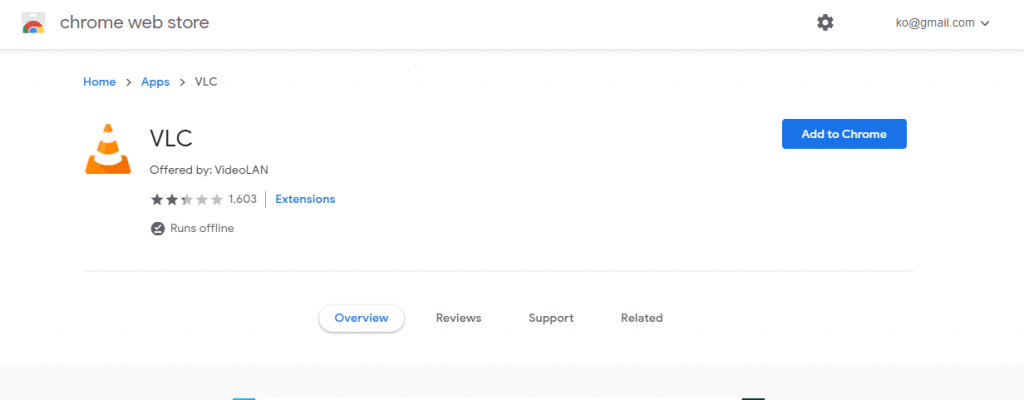

- #Vlc for chromebook free download full#
- #Vlc for chromebook free download password#
- #Vlc for chromebook free download download#
- #Vlc for chromebook free download windows#
Type “wget …undleId=106238 ” then press Enter.
#Vlc for chromebook free download download#
You’ll download the Java 8 application from Oracles website. Type “mount -o remount, exec, rw/” then press the Enter key on your keyboard.Next, you’ll need to make the system file writable.
#Vlc for chromebook free download password#
If you’ve set your own shell password previously, it may be that password. Depending on the Chrome OS build you are using, the password could be “chronos”, “chrome”, “facepunch”, or “password”.
Type “sudo su” (no quotes) and press Enter on your Chromebook’s keyboard. (Don’t worry if you don’t know the difference between these shells it isn’t important for this tutorial.) Now you’ll be able to run commands with sudo, which enables you to run commands as “root” from your ordinary user account. #Vlc for chromebook free download full#
Then, type ‘shell,’ which opens the full Bash shell. Press the Ctrl + Alt + T keys on the keyboard, to open the Crosh shell.
#Vlc for chromebook free download windows#
You should also keep in mind that your Java installation may be unstable, or it may not work at all Chromebooks are designed for people who only need access to the basics, so they’re relatively simple and pared-down when compared to other operating systems.īut if you decide that you still want to try installing Java itself, proceed with caution.Īfter putting your Chromebook device in developer mode and logging in to your device, you’ll proceed to open the command shell it’s similar to the Terminal you would use with Windows or Mac.

If you want to put a full-fledged Java installation on your Chromebook, however, then there are some additional steps to take. And it was no more difficult than adjusting your settings at any other time for any other purpose. Any site you visit which requires Javascript should now run correctly within the Chrome browser on your Chromebook device. You’ve now enabled Javascript to run on your Chromebook. Check off the circle next to ‘Allow all sites to run Javascript (recommended),’ if it isn’t already selected.
You’ll see Javascript listed as the third item down in the pop-up window that appears. Then, go down to Privacy Settings and click the gray Content Settings button. Scroll down to the Show Advanced Settings link, which is highlighted in blue.  Then, click on the gear icon, which brings you to your Chromebook settings. Go to your profile picture in the lower right-hand side of your Chromebook and then click on it. The easiest way to let Javascript run on your Chromebook device is as follows in these instructions: This is done simply by adjusting the settings on your Chromebook. It would generally be at the 80, 160, or 320 marks in the EQ dashboard.I’ll start with the simplest option: allowing Javascript to run on your Chromebook. If your main issue is with hearing people's voices, try increasing only the appropriate frequencies. Of course, Ears is also an equalizer app, so you can boost individual frequencies too. Those are good signs of pushing the speakers beyond what's healthy for them. I'd advise stopping the moment people's voices start cracking or the bass thump sounds shrill rather than deep. The higher you drag the volume booster, the more distortion you will hear. Click and drag it up to boost the volume. It will be at your computer's preset max level when you start. While there are other extensions that do this, I found Ears to be the best because it has a simple volume bar at the left. As long as the page is playing audio, Ears can boost the volume. If the volume of a YouTube clip or your favorite podcast is too low, there's an easy extension to boost that, called Ears.Įars is an equalizer that works with any web page open in Google Chrome. On a Chromebook, most of your time is spent in the Chrome browser.
Then, click on the gear icon, which brings you to your Chromebook settings. Go to your profile picture in the lower right-hand side of your Chromebook and then click on it. The easiest way to let Javascript run on your Chromebook device is as follows in these instructions: This is done simply by adjusting the settings on your Chromebook. It would generally be at the 80, 160, or 320 marks in the EQ dashboard.I’ll start with the simplest option: allowing Javascript to run on your Chromebook. If your main issue is with hearing people's voices, try increasing only the appropriate frequencies. Of course, Ears is also an equalizer app, so you can boost individual frequencies too. Those are good signs of pushing the speakers beyond what's healthy for them. I'd advise stopping the moment people's voices start cracking or the bass thump sounds shrill rather than deep. The higher you drag the volume booster, the more distortion you will hear. Click and drag it up to boost the volume. It will be at your computer's preset max level when you start. While there are other extensions that do this, I found Ears to be the best because it has a simple volume bar at the left. As long as the page is playing audio, Ears can boost the volume. If the volume of a YouTube clip or your favorite podcast is too low, there's an easy extension to boost that, called Ears.Įars is an equalizer that works with any web page open in Google Chrome. On a Chromebook, most of your time is spent in the Chrome browser.







 0 kommentar(er)
0 kommentar(er)
